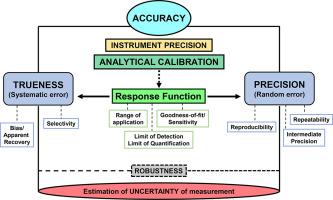Trends in Analytical Chemistry ( IF 11.8 ) Pub Date : 2020-05-11 , DOI: 10.1016/j.trac.2020.115913 Francisco Raposo , Carolina Ibelli-Bianco

|
The main objective of method validation process is to prove that an analytical method is acceptable for its intended purpose. The necessity for laboratories to use fully validated methods is now universally accepted as a way to obtain reliable results. There are diverse documents for method validation including information about different performance parameters. The classical performance characteristics are accuracy, limit of detection, precision, recovery, robustness, ruggedness, selectivity, specificity and trueness. Unfortunately, contradictory information is normally present among the method validation documents used by laboratories. The inconsistency about the performance parameters can generate some degree of confusion in the complete method validation process. This manuscript addresses controversial and discrepant information, focusing specifically on several national and international method validation guidelines published by prominent organizations and institutions which serve as guidance to validate new analytical methods by practitioners working in different fields.
中文翻译:

分析方法验证的性能参数:众多准则之间的争议和差异
方法验证过程的主要目的是证明分析方法可以满足其预期目的。实验室使用经过充分验证的方法的必要性现在已被普遍认为是获得可靠结果的一种方法。有多种方法验证文件,包括有关不同性能参数的信息。经典的性能特征是准确性,检测极限,精度,回收率,鲁棒性,坚固性,选择性,特异性和真实性。不幸的是,实验室使用的方法验证文件中通常存在矛盾的信息。性能参数的不一致会在整个方法验证过程中产生一定程度的混淆。该手稿解决了有争议和不一致的信息,











































 京公网安备 11010802027423号
京公网安备 11010802027423号